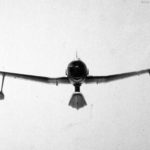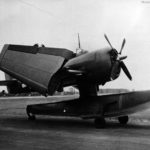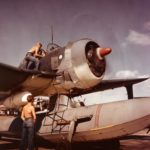SC-1 over Patuxent River July 31, 1944
SC in flight
SC-1 over Patuxent River July 31, 1944 2
SC-1 with wings folded June 1945 2
SC Seahawk 1945
SC-1 with wings folded June 1945
SC recovered by USS Chicago August 1945
SC-1 June 1945 3
SC on board USS Duluth CL-87 June 5, 1945
Curtiss SC-1 Seahawk of the VCS-10 1944-1945, color photo
Curtiss SC-2 in flight
Curtiss SC-1 Seahawk Scout Seaplane
Curtiss SC being launched
SC-1 near USS Alaska, March 1945 Iwo Jima
SC-1 Seahawks ready to be catapulted from USS Los Angeles CA-135 1945
Curtiss SC-2
Curtiss SC-1 Seahawk of the VCS-10 1944-1945
Curtiss SC-1 near USS Alaska (CB-1) – March 1945 Iwo Jima
Seahawks in flight
XSC 1 Seahawk with folded wings
SC-1 Seahawk seaplane takes off
XSC-1 propeller blades bent after nosing over during an errant landing at NAS Patuxent River, Maryland 16 December 1944
Curtiss SC Seahawk
The Curtiss SC Seahawk (Model 97) was a scout seaplane designed by the Curtiss for the U.S. Navy.
Powerplant: 1350 hp Wright R-1820-62 Cyclone (SC-1) or 1425 hp R-1820-76 (SC-2).
Serials
XSC-1: 34095, 34096, 35298 – 35300
SC-1: 35301 – 35797, 93302 – 93367
XSC-2: 35202
SC-2: 119529 to 119538
Design and Structure
- Type: Single-seat, shipborne scout.
- Wings:
- Configuration: Low-wing cantilever monoplane with a rectangular center section and tapered, dihedral outer sections. The wings include square detachable tips and fold back for shipboard storage. They are of an all-metal stressed-skin structure with full-span automatic leading-edge slots and slotted flaps inboard of the ailerons.
- Fuselage:
- Design: All-metal stressed-skin structure, circular in cross-section at the front, transitioning to an oval shape towards the rear.
- Tail Unit:
- Type: Cantilever monoplane with an all-metal structure. The elevators and rudder have trim-tabs.
- Floats:
- Configuration:
- Central single-step float mounted on a streamlined pedestal, accommodating bomb load or auxiliary fuel tanks.
- Two wing-tip stabilizing floats on single cantilever struts.
- Wheel landing gear can replace the float gear for ferrying operations, using the same attachment points. The central float includes catapult points and a hook under the nose for net pick-up.
- Configuration:
Power Plant
- Engine:
- Type: Wright R-1820-62 nine-cylinder radial air-cooled engine.
- Propeller: Curtiss electrically-operated airscrew with four hollow steel paddle-type blades.
- Fuel: Main fuel tanks are located in the wing center section, with auxiliary tanks optionally in the main float.
Accommodation and Equipment
- Cockpit:
- Positioned over the wing with a sliding blister-type canopy. For sea-rescue missions, a bunk can be installed behind the pilot’s seat.
Armament
- Guns:
- Two .50-cal. machine guns mounted in the wing center section, one on each side of the fuselage.
- Bombs:
- The central float can carry bombs or depth charges, which are housed in bomb doors controllable from the cockpit.
Dimensions
- Span: 41 ft. (12.5 m)
- Length: 36 ft. 5 in. (11.1 m)
Bibliography
- Billy Jack Long: Curtiss SC-1/2 Seahawk Naval Fighters Number Thirty-Eight
- Curtiss: Company Profile 1907-1947 Aeroplane Company Profile, 2014
- Peter M. Bowers: Curtiss Aircraft 1907-1947
- John M. Elliott: The Official Monogram U.S. Navy & Marine Corps Aircraft Color Guide Vol. 2 1940-1949
- Thomas E. Doll, Barkley R. Jackson: Navy Air Colors: United States Navy, Marine Corps, and Coast Guard Aircraft Camouflage and Markings Vol. 1 1911-1945; Squadron/Signal Publications 6159
- Gordon Swanborough, Peter M. Bowers: United States Navy Aircraft since 1911





















